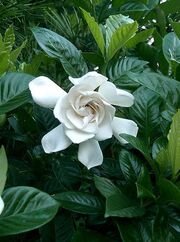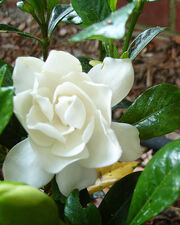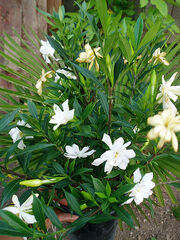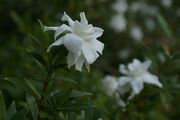| Gardenia jasminoides | |
|---|---|

| |
| Gardenia jasminoides | |
| Scientific classification | |
| Kingdom: | Plantae |
| Unranked: | Angiosperms |
| Unranked: | Eudicots |
| Unranked: | Asterids |
| Order: | Gentianales |
| Family: | Rubiaceae |
| Genus: | Gardenia |
| Species: | G. jasminoides |
| Binomial name | |
| Gardenia jasminoides J.Ellis | |
| Synonyms | |
|
Gardenia augusta (L.) Merr. (nom. illeg.) | |



Gardenia jasminoides (also known as Gardenia augusta) is a fragrant flowering evergreen tropical plant, a favorite in gardens worldwide. It originated in Asia and is most commonly found growing in Vietnam, Southern China, Taiwan, Japan and India. With its shiny green leaves and fragrant white summer flowers, it is widely used in gardens in warm temperate and subtropical climates. It has been in cultivation in China for at least a thousand years, and was introduced to English gardens in the mid 18th century. Many varieties have been bred for horticulture, with low growing, and large- and long flowering forms.
Taxonomy and naming[]
Gardenia jasminoides was described by English botanist John Ellis in 1761, after it had been conveyed to England in the 1750s.[1] It gained its association with the name jasmine as the botanist and artist Georg Dionysius Ehret had depicted it and queried whether it was a jasmine as the flowers resembled the latter plant. The name stuck and lived on the old common name and scientific epithet.[1] The name G. augusta of Linnaeus has been ruled invalid.
Common names include Cape Jasmine or Cape Jessamine, derived from the earlier belief that the flower originated in Cape of Good Hope, South Africa.[1] It is known locally as Zhizi 梔子 in China, Kuchinashi in Japan, Tiare Teina in the Cook Islands, গন্ধরাজTemplate:Clarification needed in Bengali and Indra kamla इन्द्र कमल in Nepali.
Description[]
Gardenia jasminoides is a shrub with greyish bark and dark green shiny leaves with prominent veins. The white flowers bloom in spring and summer and are highly fragrant. They are followed by small oval fruit.[2]
Cultivation[]
Gardenia jasminoides is generally considered to be somewhat difficult to take care of.
As a tropical plant,Template:Cn it thrives best in warm temperatures in humid environments. Getting those conditions is rather hard when in non tropical latitudes, reason for which gardenias are usually cultivated indoors or in greenhouses. In warm places, though, it can be grown outdoors. Either way, it prefers bright indirect sunlight or partial shade, rather than direct sunlight.
Apart from the difficulties in creating the suitable conditions for the plant to live, Gardenias need to be planted in an acidic soil (it is an acidophile plant). If the soil is not acid enough, many of its nutrients (especially iron compounds) will not be available for the plant, since they won't dilute in water and therefore won't be absorbed via the roots. It this happens, gardenias start to develop chlorosis, whose main symptom is a yellowing of the leaves. (See Soil ph).
For this reason, it's advisable not to water Gardenias with very hard water. When having to water with hard water, it is possible to add some vinegar or lemon juice to it before doing so, this will lower the pH of the water.
Iron chelate can be added to the soil in order to lower the pH, but care must be taken since an overdose can kill the plant, as with any other inorganic soil amendment.
Some gardeners will spill vinegar over the soil to effectively keep the pH low and prevent chlorosis. This can be carried out either regularly or when the first symptoms of chlorosis have been spotted.